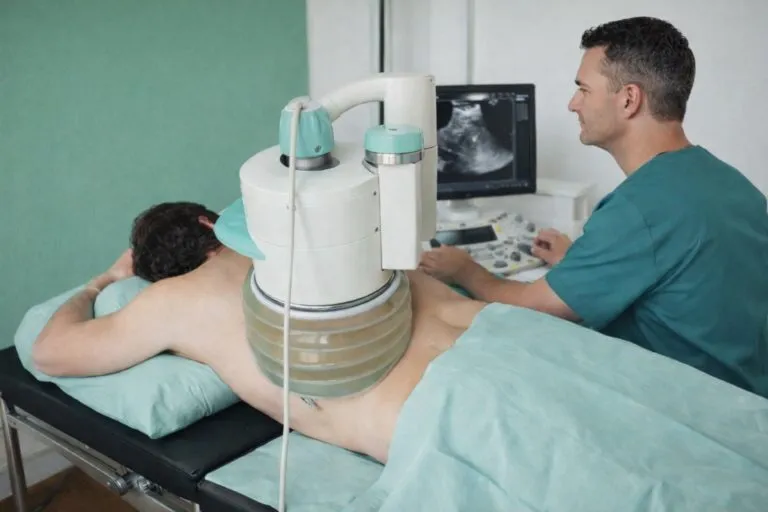Lithotripsy – is a modern method of non-surgical or minimally invasive stone fragmentation in the kidneys, ureters, and urinary bladder, followed by their natural elimination from the body. The procedure makes it possible to break down calculi of various densities and sizes without damaging surrounding tissues or organs. It is a safe and effective solution that helps eliminate the manifestations of urolithiasis without surgery or lengthy recovery.

Lithotripsy (Urinary Tract Stone Fragmentation)
We perform laser and ultrasound stone fragmentation for renal colic and urolithiasis with precise visualization, minimal tissue trauma, and rapid recovery.
- Top-Grade Doctor, PhD in Medicine
- Expert-Class Equipment
- Fast Diagnostics and Preparation
- Transparent Cost Calculation
Cost of Lithotripsy at New Life Clinic
The cost depends on the stone’s size and location, the complexity of the procedure, and the chosen method. On average, the price of lithotripsy in Kyiv is determined after a urologist consultation and diagnostic evaluation. You can clarify the current prices and choose the optimal treatment option during your appointment with a specialist.
Stone Crushing Expert at New Life Clinic

Dr. Rodion Fedorishyn is a leading urologist at New Life Clinic. For over 25 years, he has specialized in the treatment of kidney and ureteral stones, performing all types of stone removal procedures in the urinary system – laser lithotripsy, ureteroscopic procedures, and extracorporeal ultrasound fragmentation. He has performed thousands of successful surgeries and endoscopic interventions.
Dr. Fedorishyn is the author of more than 50 scientific papers, one monograph, and two patents in the field of urology. Patients value him for his professionalism, attention to detail, and ability to choose the most gentle and effective treatment method.
Patient Reviews
The language, style and spelling of the authors are preserved
Why Choose Lithotripsy at New Life Clinic

Same-Day Procedure

Comfortable Procedure

Fast Recovery

Result Monitoring and Prevention
Stone Removal at New Life Clinic: Key Figures
When Lithotripsy is Required
Stone removal is needed when a stone begins to obstruct normal urine flow and causes significant discomfort. Such situations are risky because they quickly lead to pain, inflammation, and impaired kidney function.
Main Signs That Lithotripsy Is Required:
- sharp or recurring pain in the side, lower back, or groin
- renal colic
- impaired urine flow (frequent urges, difficulty urinating)
- the stone blocks the ureter or becomes lodged in it
- the stone increases in size according to ultrasound
- the stone does not pass on its own within 2 to 4 weeks
To choose the appropriate method of stone removal, ultrasound and basic tests are performed to assess the stone’s size, density, and exact location.
Procedure Features
The method of stone removal depends on its location, size, and density, as well as whether it obstructs urine flow or causes pain. Below are the main options for stone fragmentation in different parts of the urinary tract. After the examination, the doctor selects the safest and most effective method.
-
Kidney Stone Removal
-
Ureteral Stone Removal
-
Bladder Stone Removal
Modern Types of Lithotripsy at New Life Clinic
All major types of lithotripsy are performed at New Life Clinic. Choose a method below to visit its page and learn about indications, procedure steps, and benefits.
Answers to Common Patient Questions
Many patients want to know how stone fragmentation is performed in the kidneys and other organs. Questions about safety, recovery, and possible limitations are very common. The cost of the procedure is usually the first concern. Below we have collected clear and honest answers from the urologist to the most frequent questions about lithotripsy.
-
How Long Does It Take for Stones to Pass After Fragmentation?
-
How Many Times Can a Kidney Stone Be Crushed?
-
After Which Lithotripsy Method Is a Stent Placed?
-
Why Is a Stent Placed After Stone Removal?
-
What Helps Relieve Pain After Kidney Stone Removal?
-
How Should You Live After a Kidney Stone Is Removed?
Leave a Request – We Will Find a Convenient Time for You
Equipment and Facilities at New Life Clinic
At the urology department of New Life Clinic, all conditions are created for safe and precise stone removal. We use expert-level equipment and pay attention to every stage of treatment. Below are photographs of our rooms and operating areas where lithotripsy procedures are performed.
The content of this page has been approved by the urologist of New Life Clinic (Rodion Fedorishin, urologist with 28 years of clinical experience, Ph.D.).







































